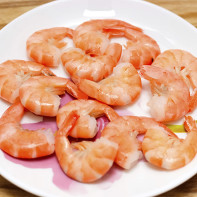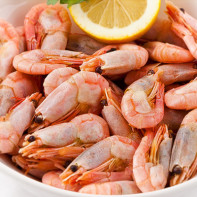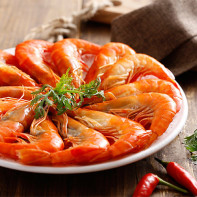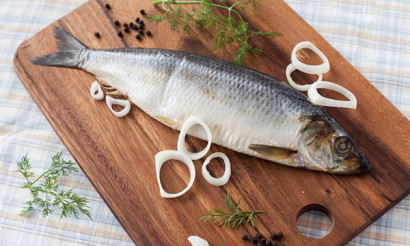How to cook shrimp: recipes
Today over 3.5 million tons of shrimp are harvested per year: fishing trawlers catch it far from the coast in deep waters, where the catch is immediately processed and frozen. Small vessels are caught in coastal waters. In addition, crustaceans are successfully grown in artificial conditions, today it has become a profitable business for the countries of South America, southeast Asia, as well as India and China.
- What is shrimp?
- Views
- What are the benefits of shrimp?
- How to choose the right shrimp
- How to defrost shrimp to preserve their taste
- How to cook shrimp
- Frozen shrimp
- Classic recipe
- With spices
- With onion
- With wine
- Fresh shrimp
- Unpeeled
- Peeled
- With lemon
- For beer
- For salad
- For sushi
- In the microwave
- In a slow cooker
- In a double boiler
- How to clean shrimp
- How to brush your hands
- Using kitchen scissors
- Do I need to cook shrimp before frying
What is shrimp?
Shrimps are crustaceans, which zoologists attribute to the order of decapods. In addition to giving the squad ten running legs (or five pairs) attached to the chest, the shrimp has five more pairs of small swimming limbs (swimmer) and three pairs of upper, called forage appendages.
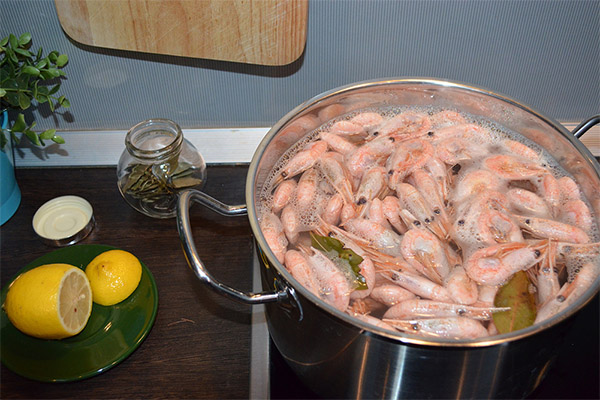
Shrimp breathe with gills - like all crustaceans. However, they have several interesting features. So, from time to time they drop and change the shell, not all crustaceans have this ability. And the heart, reproductive organs, digestive system and urinary system are located next to the head.
Shrimps have mastered the waters of the largest oceans of the planet - the Pacific, Atlantic, settled in warm seas - such as the Black, Mediterranean and others. The greatest number of them inhabits the water expanses along the equator; as they move into cooler zones, the number of shrimps decreases. Some species even settled in fresh waters.
In food, these crustaceans are unpretentious, feed on plankton, small particles of algae, and eat worms and larvae of various insects found in water with pleasure. And especially large individuals can even swallow fry.
Views
Adult shrimp can grow from 2 to 30 cm, its size depends on the species, there are about 2000 in total. They are divided into marine and freshwater, warm-water and northern. About a hundred species of crustaceans are found in Russian waters.
Shrimp entering the shelves are divided into three groups:
- The first is the most extensive, the northern or Atlantic variety belongs to it. She has a few more names: wild, sweet, magadan. This crustacean is not large, and the meat is slightly sweet, rather dense, firm, pale pink. On the price tags for these shrimps and on the packages with them, numbers are written that indicate the approximate number of crustaceans per 1 kg - for example, the combination 90/120 is most often found, that is, 1 kg contains from 90 to 120 shrimps.
- The second group is tiger prawns, they got their name because of the dark stripes passing through their body. These large - up to 650 g - crustaceans are found in the Indian Ocean, Sea of Japan, but those that go on sale are most often grown artificially. It is not difficult to distinguish an individual grown in farm conditions: the blacker the carapace and the contrasting the white stripes against its background, the more likely it is not from the sea. In addition, it is the artificially grown shrimp that are large in size - up to 35 cm, while the sea shrimp does not exceed 25 cm. The taste of tiger shrimp meat is tender and juicy, not without reason it is considered a delicacy. Usually they are sold not frozen, but simply frozen: in this way, the producers retain the natural color of their shell.
- The third group of shrimps is royal, and this is not the name of a particular species, it combines several species. They are much larger than usual, but they do not have a tiger color. They are easy to recognize by their large heads.King prawn meat tastes sweetish and contains less protein than other crustacean species. And usually they are artificially grown.
What are the benefits of shrimp?
The benefits of shrimp meat for the human body have not been disputed for a long time, since scientists have found that the composition of this seafood is not only healthy products, but also their unique combination.
In essence, this is a protein product, respectively, it not only “feeds” the human body, but also forms the muscles of the body and helps the skin stay taut and elastic longer. There are practically no carbohydrates in shrimp meat, few fats. In addition, it contains a rich set of vitamins: group B is present almost completely, there are also A, C, E, K.
The list of “benefits” of shrimp meat includes 12 valuable and essential amino acids, healthy cholesterol and omega-3 fatty acids, as well as an impressive complex of micro and macro elements, especially a lot of iodine, zinc, selenium, manganese, iron, cobalt, fluorine, molybdenum, calcium, sodium, magnesium, phosphorus, potassium. Thanks to this balance, shrimp, if eaten regularly, will help prevent many diseases, including cardiovascular and even serious ones like heart attack, stroke, and hypertension.
The systematic use of shrimp eliminates problems in the thyroid gland, prevents hair loss, and thanks to selenium and astaxanthin, it prevents the development of tumors.
For women, this seafood is also useful in that it stabilizes the hormonal background and normalizes the functioning of the genital organs. In addition, almost all women always dream of losing weight. Shrimp is the product with which the process of losing weight is not only effective, but also pleasant. It is not only low-calorie, but also capable of accelerating metabolic processes in the body, which ultimately reduces body weight.
Pregnant women can eat shrimp, as this will only have a positive effect on the development of the fetus. And selenium and zinc as a part of shrimp meat will serve an excellent service to the stronger sex, because they perfectly stimulate the production of the hormone valuable for men - testosterone and increase potency.
If you regularly feed shrimp to a child older than three years, the complex of substances contained in them will help him to develop harmoniously, not only physically, but also mentally.
How to choose the right shrimp
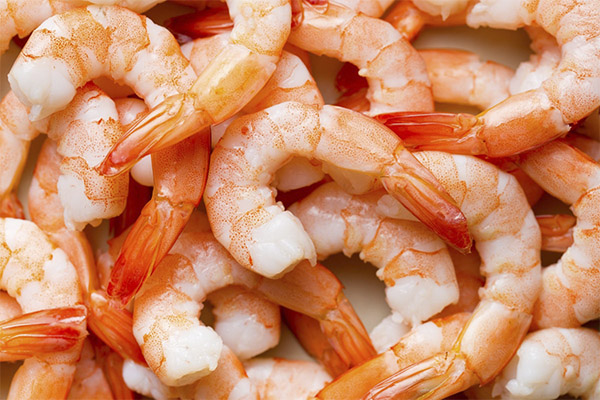
- When choosing shrimp, you first need to pay attention to the general appearance of the package: excess ice or snow is unacceptable in it, this indicates that the product has been thawed and frozen again, possibly even more than once.
- Next, you should look at the labeling of the package: the production date, period and storage conditions should be written there. Typically, storage time is 4–10 months.
- Of the two types of packaging - a plastic bag or a cardboard box with a waxed layer inside - it is better to give preference to the second, since it better tolerates transportation.
- When choosing a boiled-ice cream product, you need to pay attention to its color and shape. A good shrimp should be even in color, it cannot have spots, chips or other damage to the shell, the color of which ranges from pink-white to pink-orange. If the tail is straight, it means more than five hours have elapsed between catching and cooking the crustacean or even boiled it after freezing. In a quality shrimp, the tail is always twisted, and the stronger, the fresher the product.
How to defrost shrimp to preserve their taste
Trading networks today offer shrimp and fresh, and fresh-frozen, and boiled-frozen. Frozen boiled - most often, so they usually buy. Defrost and cook them so that they are tasty and retain all the nutrients.
According to all the rules, defrosting will take at least 8 hours. It is best to put shrimp in a colander, substitute a bowl under it so that the colander does not touch its bottom. Then the water will flow freely from the shrimp. This is the most gentle method.
If you need to defrost faster, you can shift the shrimp into a special bag, which is easy to buy at any hardware store to freeze vegetables or berries, and dip it in a basin or pot of water, the temperature of which is 39–41 degrees. This method is also quite suitable, the meat will remain tender and pleasant.
When you urgently need to serve shrimps that have just been brought from the store, you can directly put them in salted boiling water and cover them with a lid. As soon as the water boils again, wait 10–20 seconds and turn off the heat. Leave the shrimp in boiling water for another 20 minutes.
Shrimp from the freezer can immediately be put on a preheated pan with vegetable oil and fry them for 5 minutes with constant stirring.
It is impossible:
- Defrost shrimp in the microwave, as they lose nutrients, juice, and aroma.
- When defrosting, put the product in water without a bag: the juice will go into the water, the shrimp will become dry.
How to cook shrimp
It will take no more than 10 minutes to cook. If the shrimp has already been thawed, they must be washed under running water and cleaned of any foreign matter that could catch on the shell or legs of the crustacean.
Pour enough water into the cooking pot so that it exceeds the amount of shrimp by volume 2.5–3 times. You can only lower the product into boiling water, in which all the necessary seasonings are already present and salt is dissolved. To make the meat more tender, it is good to add lemon juice to the pan. As ideal ingredients, bay leaf and peppercorns - black or allspice - are always suitable. Cloves are also good friends with shrimp; basil, ground red pepper, Provence herbs, rosemary are also suitable for this dish.
Cooking these seafood is best for 2-3 minutes, if large - a little longer, this is usually specified in each recipe. As soon as they begin to emerge, then it’s ready! The shell becomes glossy by this time. Water must be drained quickly so as not to overdo the shrimp in boiling water, as they can become "rubber".
Ready-made crustaceans should be laid out in a bowl or plate, for beauty, you can make a substrate of lettuce leaves, sprinkle shrimp with lemon juice or olive oil. As a decoration, greens, olives or olives, as well as lemon rings, will go well.
Frozen shrimp
When planning to cook frozen shrimp, we must remember that it is better to defrost them first. The ideal option is in a colander or in a strainer on the shelf of the refrigerator, but can be in a dense bag for freezing in warm water. After defrosting, select one of the recipes below.
Classic recipe
Almost every housewife must undertake to try some kind of recipe for making shrimp, but exotic recipes are not always to everyone's taste. A classic - time-tested. It needs salt, pepper, bay leaf and fresh or dried dill.

To cook 1 kg of crustaceans, you need a spacious pan - at least 4 liters. Pour 2.5 liters of water into it, and pour 1.5 tbsp. tablespoons of salt. Put on the stove, and when the water begins to boil, put dill, pepper and then shrimp. Boil for 3 minutes and put 5 bay leaves. After another 2 minutes, drain the water. Together with the shrimp, serve the juice squeezed from the lemon.
With spices
For boiling 1 kg of shrimp, you need 3 liters of water. Send the pot of water to the fire, and in the meantime, large individuals - tiger or royal - first clean, so that the meat is well saturated with aromas and taste of spices.
When the water begins to boil, put 8 peas of allspice, 2 clove inflorescences into the pan, pour the juice of a whole lemon, 2 cloves of medium-sized garlic and 3 bay leaves. Stir in a pan 2 tbsp. tablespoons of tomato paste. Once the water has boiled again, you can dip the shrimp into it. To take out in a colander when they come up - so, ready. You can simply drain the water, and put the shrimp on a dish, squeeze a little juice of lemon juice on them, add 0.5 tbsp. tablespoons of olive oil.
With onion
Cut the middle onion in half rings, chop finely 1-2 cloves of garlic or pass through a garlic squeezer. Pour a little vegetable oil, preferably olive, into the pan in which the shrimp will be cooked. Put on fire and fry onions and garlic.
For this cooking method, you do not need to defrost the shrimp - you need to put them in a pan with garlic and onions, add water so that it covers the products, and begin to stew. Salt is not necessary. From boiling water to the end of cooking should pass 3 minutes. Shrimps will turn out unusually tender, with a catchy aroma. If desired, you can season them with lemon juice or vinegar.
With wine
Defrost the shrimp in a colander to leave excess water.
Pour 2 cups of any wine into a pot with 2 liters of water. Grind one medium carrot in a blender with 3-5 cloves of garlic. Put the resulting mass in water with wine and send the pan to the stove. Add peppercorns, dried dill, bay leaf. As soon as the water boils, put the shrimp into it and boil for 3 minutes. Drain the water, and leave the crustaceans to infuse for 25-30 minutes.
Fresh shrimp
Unfortunately, housewives quite often cook fresh shrimp longer than the recommended time, fearing that they will remain raw inside. The result is a product very similar to rubber and inedible.
However, true connoisseurs of shrimp consider them the most delicious. To please such a connoisseur is actually not very difficult, you just need to strictly follow the cooking technology.
So, in order not to confuse, we must remember - fresh shrimp is always not reddish-orange, but gray. For cooking, in addition to seafood, you need to cook pepper, onions, lemon, salt, dried dill and bay leaf.
Water will need twice as much as the weight of shrimp. In a spacious dish with water, put half of the lemon cut into slices, onion and other spices cut in half - each one selects a ratio to his taste and bring everything to a boil. Then put the shrimp in boiling liquid. You need to cook their products until a pinkish or reddish shade appears. By this time, the product should come up. For orientation: as a rule, this will take no more than 6 minutes for small crustaceans and 10 minutes for large crustaceans. Drain the water by discarding the seafood in a colander. Shrimp should be served with a sauce based on olive oil and juice squeezed from the second half of a lemon.
Unpeeled
For shrimp, the main thing is not to digest. According to the rules, uncleaned boiled-frozen crustaceans must be cooked for 2 minutes, no more! Otherwise, instead of enjoying a tasty dish, you will have to chew hard rubber with difficulty.
The recipe "Nowhere is easier"
Put boiling 1.5–2 liters of water (per 500–700 g of crustaceans). Salt to taste, dip 3-4 bay leaves into the pan, peppercorns (if you wish). When the water begins to boil, put the shrimp, mix with a slotted spoon and cover. When re-drilling appears, detect a minute, turn off the fire and, without wasting time, drain the water.
To eat such a shrimp, you need to clean it. First, tear off your head from the shell, then remove it. To do this, cut each plate, and then carefully remove the carapace. Then remove the intestinal vein - this is a dark strip along the entire abdomen. So that it does not tear during the removal process, it is better to make an incision along. And that’s it - you can send meat to your mouth!
Peeled
Some shrimp lovers say that peeled crustaceans do not require cooking, they just need to lie in boiling water for 3-4 minutes. Insisted, they will be ready for use.
Other, equally passionate crustacean fans, argue that they need to be boiled, but not longer than a minute in boiling liquid.
And in that, and in another case, the willingness is easy to determine by color: the shrimp will turn orange.
Royal
Large (from the palm of an adult male) king prawns are sold both peeled and unpeeled. In general, the principle of their cooking is approximately the same, but there are small differences.
To cook king prawns, water requires 3 times more than the mass of the product.When the water has already boiled, it is necessary to pour salt into it and put the product. For unrefined shrimp, salt needs from 1.5 to 2 tbsp. tablespoons per 1 liter of liquid. Purified salt needs to be 2 times less.
Cook unpeeled seafood until cooked for 7 to 8 minutes, peeled seafood will be ready in 5 minutes. At the end of cooking, drain the water. Serving on the table, for piquancy, you can sprinkle food with red pepper.
So that the unpeeled shrimp are easier to clean, you need to hold them under a stream of running cold water.
Argentinean
Argentinean shrimp are extremely rare in stores, their peculiarity is that it is impossible to breed them in farms, they live only in the wild. Sell them always unpeeled.
After defrosting, shrimp should be washed and cut off the head. Notch along the back of the carapace, it is not necessary to remove it, it will be removed faster from boiled meat. At this stage, it is important to remove the intestinal vein.
In a saucepan, heat 3-4 liters of water to a boil and put 3 tbsp. tablespoons of salt. Since such shrimp are very large, cook them in boiling water for 4 to 5 minutes. Pour out the water after cooking, and rinse the seafood with a colander for a minute under cold running water. Put the shrimp on a beautiful dish and sprinkle with lemon juice or olive oil, sprinkle with black pepper.
Tiger
Tiger prawns are usually sold with a shell, and this makes it possible to understand that this is the very delicacy. It can be with or without a head, but in a shell. It must be cleaned after cooking, sent to a pot or pan in a chitinous “dress”. Before cooking, thaw the delicacy in a colander in order to get rid of leaking water. Bring water to a boil at the rate of 1 liter per 700 g of product and pour salt into it - 2 teaspoons per 1 liter of liquid.
Add the juice squeezed from half a lemon, put 4–5 peas of pepper and lower the shrimps into a boiling broth. Boil for about 2-3 minutes at a boil, then quickly drain the water, and put the shrimp on a wide plate and peel - remove the carapace and remove the intestinal vein, then pry it with a knife and remove the entrails from the abdomen. It remains to rinse the meat with clean water - the delicacy is ready to eat.
With lemon
In order to cook shrimps with lemon, in addition to actually 1 kg of seafood, you will need a large bay leaf, a pair of allspice peas, 1 tbsp. a spoon of dry dill, one medium-sized lemon, 3-4 cloves of garlic and 2.5-3 tbsp. tablespoons of salt (anyone who loves saltier, you can slightly increase the rate).
For 1 kg of shrimp, you need 2 liters of water, which is brought to a boil and boiled for 5 minutes, adding all the spices to it (take half a lemon and cut it into pieces beforehand). Only then can shrimp be dipped in boiling water. From the moment of boiling, cook them for 5-6 minutes, no more. Drain and pour the shrimp over the juice squeezed from the second half of the lemon.
For beer
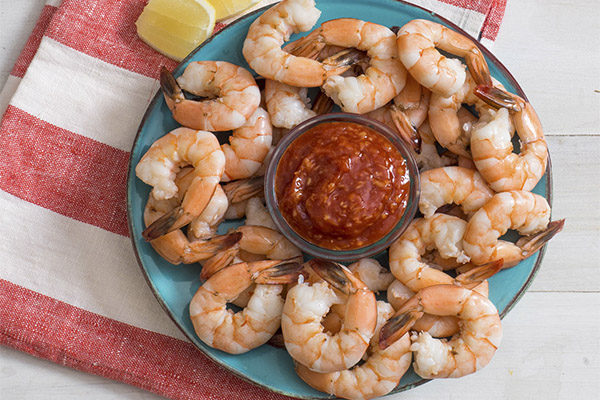
With cloves
Beer shrimp should be spicy, and therefore you need to take more spices and a variety of spices. For 0.5 kg of crustaceans - 5 medium-sized bay leaves, 6-7 inflorescences of cloves, peppercorns, you can not spare and put 12-15 pieces. For 1.5 liters of water you will need 1 teaspoon of salt. Boil the marinade based on all the spices, gently dip the seafood into it and cook for about 3 minutes. Then pour the liquid, throwing the shrimp through a colander, and arrange the seafood on a beautiful plate and pour for the taste of juice squeezed from half a lemon.
With soy sauce
To cook shrimp according to this recipe, you will not need a pan, but a frying pan. Of the products, in addition to 500-700 g of crustaceans, olive oil, a bunch of parsley, leek (1 pc.), Garlic (2-3 cloves), lemon and soy sauce should be cooked for frying. If the shrimp are large - first you need to cut the shell on the back and remove the intestinal vein.
Leek cut into rings and put on a preheated pan with olive oil, fry a little, the fire under the pan should be small. Add the garlic passed through the crush to the onion and put the shrimp in a minute.Add fire under a frying pan, add to the taste of squeezed lemon juice and pour soy sauce (100 g) in another minute, sprinkle with parsley, mix all the ingredients, cover the frying pan with a lid, make the fire smaller and darken its contents for a couple of minutes. All shrimp are ready! They will go perfectly to beer.
In beer with garlic
For beer, you can boil shrimp in beer. You get an interesting taste with a light pleasant aroma. For 0.5 kg of seafood you need to take 2 bay leaves, the same amount of garlic cloves, 6 peas of allspice, ground black pepper, butter (4 tbsp.), Salt to taste and a glass of beer, preferably light.
In a saucepan, pour seafood with beer, put on medium-high heat. Put all the spices there - garlic, peppercorns, bay leaf. Salt to taste, bring the contents of the pan to a boil and boil the crustaceans at the boil for 2 minutes.
While the shrimp is cooking, melt the butter in a water bath. Remove the shrimp from the dishes with beer, put them on a plate and pour them with melted butter.
For salad
For the salad, you need peeled shrimp, but you can buy it in a shell, and clean it after cooking. By the way, this is the case when small crustaceans will go quite well.
For boiling 1 kg of raw seafood, you need to take 2.5 liters of water, into which pour 1 tbsp. spoon of salt and put 5 peas of pepper and 2 bay leaves. Boil the shrimp for 4 minutes, drain with a colander and rinse with cold running water for a minute - so they will be better cleaned. Having removed the upper part of the carcass (head), it is necessary to remove the shell, holding each crustacean by the tail, there will be no difficulties.
Prepared meat can be poured with juice squeezed from lemon, if necessary, add a little more salt. It is good to add shrimp to Caesar salad.
For sushi
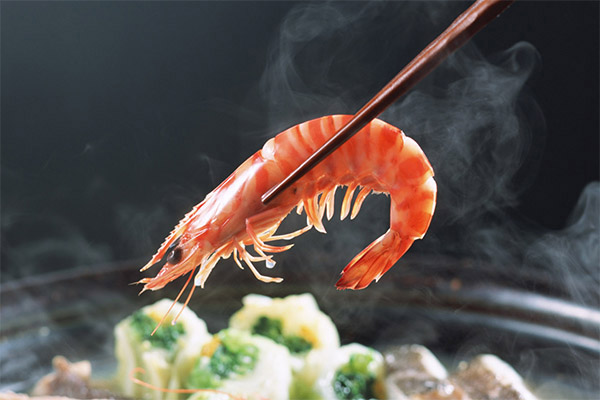
Boiled
For sushi, shrimp should be put on skewers and directly onto them in boiling, salted to taste water. Cooking time directly depends on the size - from 5 to 10 minutes, if the shrimp were fresh, if they are boiled, 2-3 minutes are enough.
Next, you need to remove the skewers from the water, remove the shrimp, cool and proceed with cleaning. First of all, remove the legs, then, using a sharp knife, carefully cut the carapace and carefully remove as much. Then incise the shallow abdomen along so that the abdominal line can be easily pulled out. To remove the tail or not, depends on the circumstances, in some sushi it is needed.
Fried
You can prepare shrimps for sushi by frying them in a pan in your favorite vegetable oil, in which add garlic whole slices (2-3 pcs.) For flavor. Whether they are in a shell or not, do not keep them on the stove for more than three minutes, then remove from the pan with a slotted spoon and lay them on a paper towel to remove excess fat, and only then clean it. You can also fry seafood in deep fat, planting them on skewers.
In the microwave
Before cooking in the microwave, shrimp need to be thawed, it is better to take those in the shell, it will better hold the juice. The main point - you can not overexposure seafood longer than the recommended time, so that they are not overdried.
Fold the crustaceans in a special dish for the microwave; there must be a hole in its lid to let off steam. Turn on the microwave oven at maximum power, cook about 2-3 minutes. When cooking is complete, salt, sprinkle with ground pepper and serve.
In a slow cooker
Shrimps cooked in a slow cooker with garlic and chopped herbs will certainly cause a sensation at the dinner table. For 0.5 kg of peeled seafood, you need to cook garlic (2 cloves), parsley, dill, feathers of green onions.
Chop greens with garlic with a knife. Pour 1.5 to 2 liters of water into the multicooker bowl and put greens and garlic in it. Add salt, pepper and a couple of bay leaves.Close the slow cooker and set the mode to “Steaming” or “Cooking soup”. Put the shrimps thawed from ice into boiled water, cook for 3 to 5 minutes with the lid open. Next, turn off the heat, drain the broth, and put the shrimp on a plate. If dinner is planned - you can cook rice for a side dish.
In a double boiler
If you cook steamed shrimp, they will remain juicy. One load of a double boiler requires 12–14 large headless individuals.
Thawed seafood put in a bowl and soak them in brine for half an hour (1 liter of water, 2 tbsp.spoons of salt), then put on the shelves of a double boiler, and pour the brine into its bowl for the sauce. Set the cooking time for 10 minutes.
Meanwhile, do the sauce. Mix a quail egg with a blender, 3 tbsp. tablespoons of olive oil, 1 teaspoon of finished mustard, 1 tbsp. a spoonful of lemon juice, 0.5 teaspoon ground red pepper, a clove of garlic and a sprig of basil.
Put the finished shrimp on a wide plate and serve homemade sauce with them, optionally with a cup of wasabi.
How to clean shrimp
Shrimp can be cleaned with both hands and kitchen scissors.

How to brush your hands
Begin by removing the shrimp's head and legs. To remove the carapace, sliding your fingers along it from head to tail, separating each plate in turn. This must be done carefully so that the meat remains unscathed. The tail can be removed or left as a decoration - for example, for sushi or rolls. But it is necessary to remove the longitudinal dark abdominal thread.
Using kitchen scissors
First, as in the first embodiment, remove the legs and head and proceed to release the meat from the shell. With scissors, slightly incise it on the back, from the side of the head, and continue to cut to the tail. After that, the carapace can be easily opened and removed. It remains only to remove the dark strip along the abdomen, for which, with a knife, carefully make a shallow cut and pick it up with the tip of the knife.
Do I need to cook shrimp before frying
Shrimps do not need additional boiling before frying, even large royal individuals can be immediately fried in oil, moreover, even put them in a frying pan directly from the freezer.
Cooking time for such seafood is 10 minutes, if the seafood is freshly frozen and in shell, 5 minutes - when they are not peeled, but cooked-frozen. Peeled and thawed king prawns are fried in just 5 minutes.
Pour oil into a pan, heat it over high heat and put shrimp, while reducing the fire. Cover the pan with a lid and wait a couple of minutes, then turn over the shrimp, salt, pepper, sprinkle with dill, caraway seeds, chopped garlic. Cover and turn off after a minute.
«Important: all information on the site is provided exclusively in fact-finding purposes. Before applying any recommendations, consult with a profile specialist. Neither the editors nor the authors are liable for any possible harm caused materials. "

